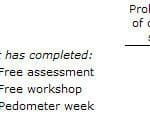As a wellness business owner, it’s easy to focus on what you’re not doing or not doing right. But what about the things you’re already doing?
Here are the 5 most common business practices we encounter that we wish our clients would just… stop doing!
1. Dropping thousands of dollars on “proven sales systems”
Most of the time, the only thing proven about them is that they sell well to folks who haven’t done their homework and are looking for a magic bullet that will catapult their business to the next level.
That magic bullet isn’t a special set of words that makes prospects swoon and fall over gushing money when they hear it. It’s understanding who your customers really are, why they like YOU and not someone else, and why they keep coming back; then bit by tedious bit, creating an environment that consistently and predictably meets those needs at a reasonable price.
2. Letting some college kid handle your social strategy
Just because you’re “old school” and don’t really post much on Facebook or Instagram doesn’t let you off the hook when it comes to engaging customers. The fact is that practically everyone you’re targeting uses social media, and as a business you can’t ignore it.
Neither can you just create a business Facebook page and occasionally post your opinion about ketogenic diets, whether CrossFit got it right or stepped in it, and so forth.
When it comes to social media, your main goal is to create a sense of community (or be part of one) that drives interest in the products or services your business has to offer. That means understanding who your prospective customers are and where they hang out, listening intently to the kinds of things they talk about, offering tidbits of unbiased expert advice (not too much!) on specific wellness related topics, and building an image of you and your business as someone who can be trusted to help customers along their journey to wellness.
In other words, not typically what Chloe the sophomore History student does between classes.
3. Playing office
We’ve talked to a number of prospective clients lately who focus inordinate amounts of time on thinking up and designing programs in great detail for customers they can’t seem to find.
To us, this is getting the process backward. Let’s say your business focuses on disordered eating in women over 40. Start with an analysis — using data from wherever you can get it — of what your target customer is thinking about, what their goals actually are, and what the obstacles to those goals usually seem to be. DO NOT GUESS, and do not head straight to program development until you have an answer.
Not all customers are the same. Not all similar customers are even in the same stage of buying behavior. Moreover, your own personal wellness transformation — often the driving factor for many of our clients entering the wellness business — is just one example of such transformation. It’s not a business model unless you intend to sell only to yourself or people exactly like you. Think instead about several people other than yourself that you think your business might be able to help. What do they have in common? Why would they visit your business? Why aren’t they already there?
These are the things you should be focused on FIRST. You have to be able to draw a solid line from a population of prospective customers, to their needs, to your business. If at any point you’re wondering where that line ought to be drawn, you’re not on task. If you’re just drawing it based on personal experience, you’re probably going in the wrong direction. If you can’t see your customers following that line, then you’re going after the wrong customers.
Once you know who your customers really are, you can design programs for them.
4. Spending all your time on wellness and none on business
Think of this as the complement to the business practice above. When you got into chiropractic or physical therapy, you probably didn’t really want to be an accountant, did you? A human resources manager? Maybe a facilities manager, maintenance custodian, or maid service?
Yet if you run a fitness or wellness business, you will have to conduct performance reviews, write paychecks, make sure the A/C is working and towels are picked up, or call to have broken equipment fixed. What’s worse, you need to develop a reasonable budget for day to day operations, think about cash flow, pricing, and customer retention.
The good news is that if you devote a reasonable amount of time to these things, they tend to take care of themselves. Picking up towels and keeping equipment working helps with customer retention. Hiring the right people can mean fewer worries about employees who feel they aren’t paid enough to be nice to customers. And so on.
Yes, each one takes you a little farther away from the day-to-day wellness practices that got you interested in the field in the first place. But it’s part of what it means to be in business.
If you do it right, you’ll get a sense of reward that makes it feel more than worthwhile.
5. Spending too much time working on the business and not IN it
It’s possible to get so focused on program development, budgeting, hiring and firing, training new employees, and paying the bills that you forget that somewhere out there is your yoga studio, with people in it working on asanas and making progress in finding inner peace.
If your fitness or wellness business is running reasonably well, it’s time to take a break and go walk the halls and say hello to everyone, including both customers and employees. Work out at your own facility so you can get a feel for what it’s like to be a customer. Notice who’s there, who’s smiling and who’s not. Feel the mood of the place: is it nose-to-the-grindstone, tough-as-nails determination to meet a fitness goal? Casual satisfaction at getting in one’s 30 minutes a day? Something else?
With a mind to what you CAN ACTUALLY CHANGE, ask anyone willing to talk to you how long they’ve been coming and to name one thing they love about the place and one thing they don’t like so much. Listen intently and take notes, and thank them for being willing to chat with you. Don’t take action right away unless it’s a health or safety hazard, broken equipment, burned out light bulbs, or something similar. Give yourself a week of just wondering around the place and think about what you’d change — or keep the same — for your most loyal customers. Then gradually work that into your thinking when you return to focusing on business management practices.
Think of it as a “staycation” at your business, a chance to recharge your batteries and regain focus on the people who’ve kept it going over the years.



